Abingdon to Oxford
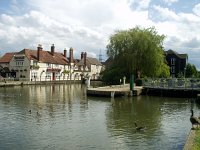
Abingdon to Oxford |  |
| Upstream: Oxford to Northmoor | Back to Main Page | Downstream: Dorchester to Abingdon |
Introduction
This walk starts in the market town of Abingdon and after crossing the abbey stream, the river runs through open countryside for several miles, passing close to Radley, to the beautiful village of Sandford-on-Thames. Here the path is on the island by the lock briefly before returning to the bank to pass through picturesque Iffley Lock and on to the stunning city of Oxford, the last major town on the Thames from London to the source.
Getting to the Start
Abingdon is just off the A34 and has good access from the M4 (from junction 13) and the M40 (via Oxford). There are a few long-stay car parks in the town, but the most convenient for the Thames Path is on the south side of the river at either Hales Meadow or Rye Farm. On the North side of the river, the nearest car park is at Abbey Close.
If you're travelling by public transport, although Abingdon does not have a station it does have an excellent bus service. Oxford Bus service X3 from Oxford runs every 10 minutes during the daytime Monday - Saturday and every 20 minutes on Sunday, normally using modern air-conditions buses. These buses also serve Oxford Station which has frequent trains from London, Leamington, Birmingham, Reading as well as many local services. Stagecoach Oxford service X4 also operates every 10 minutes during the day on Mondays - Saturday and every hour on Sundays from Oxford. If you're coming from the south or west, buses also operate frequently to Abingdon from Didcot Parkway Station, which has frequent trains from Swindon, Bristol, Reading, Slough, Oxford and London, as well as local services. Stagecoach Oxford service 32 runs hourly to Abingdon from Culham, Milton, Didcot (and Didcot Parkway station), Harwell, Wantage (with some services starting from Grove). Oxford Bus service 35A runs every 30 minutes to Abingdon from Didcot Parkway station, Monday - Saturday whilst services 35 and 35A operate every 15 minutes (Monday - Saturday) from Radley Station and also every 30 minutes on Sundays. A large number of services to other local towns and villages are also available - see the links below for more information.
The Walk
Abingdon is an attractive market town which is worth spending some time looking around as it has many historic buildings, especially along the north bank of the river. The Thames Path continues on the south bank of the river from Abingdon bridge and the town appears to end almost as soon as you cross the bridge, as the path is now through open fields once more. The river itself is usually quite well used here with a variety of long boats using the moorings near the town. Soon you can see the weir ahead.
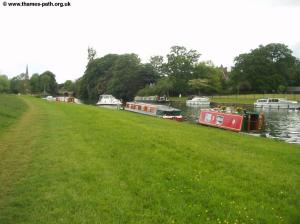 |
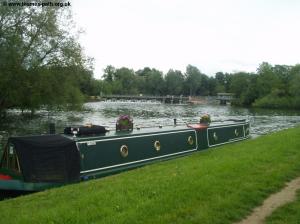 |
| Looking back to Abingdon Bridge | The Weir ahead |
Soon you come to Abingdon weir and lock where the Thames path now crosses to the opposite bank, first via the lock then over the weir.
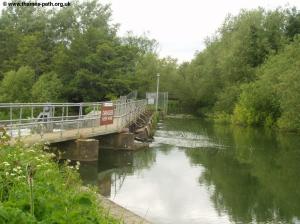 |
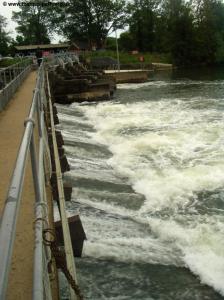 |
| Abingdon Weir | Crossing the Weir |
Once across the weir you head briefly left and cross the small footbridge over the abbey stream - the path straight ahead will take you back to Abingdon. Once over the bridge turn right and follow the well-signed path. Here the Thames is often just out of glimpse as the banks are quite overgrown. Ahead the path then goes round a small inlet where you briefly double-back on yourself to rejoin the north bank of the river, where you get good views back to Abingdon. Across the river you can see the small weir where the Back Water rejoins the main course of the river and soon you see the railway bridge ahead which you go under.
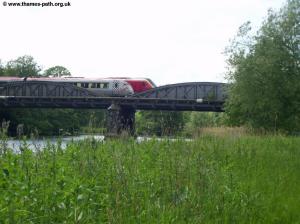 |
| A train crosses the railway bridge |
Along the path beyond the bridge there are fields to the left whilst the opposite bank is initially tree-covered. Soon you come to a lone house on your left by Pumney Farm, with it's well kept lawn. Beyond the house you'll see a pond to the left. Soon the trees to the right clear and you see a rather imposing mansion house at the top of a hill across the river - Nuneham House, parts of which date from 1756.
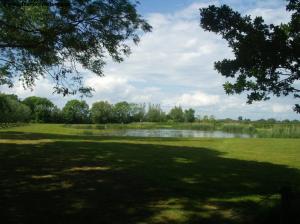 |
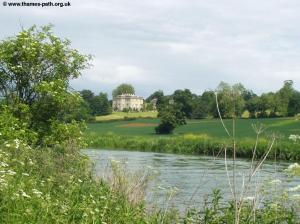 |
| The pond by Pumney Farm | Nuneham House across the river |
As you pass the large house you seen see a small boathouse on the opposite banks of the river and ahead a larger boat house on the path side of the river, marked by an old boat in the field next to the path. The road to the left here will take you to Radley station.
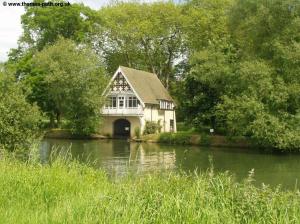 |
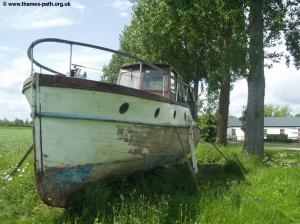 |
| The boat house across the river | An old boat by the Thames path near the boat houses of Radley |
Beyond the boat yard, the Thames continues the rural scene, with open fields and pleasant countryside. Although the path does pass a sewage works (according to the map) it is not really noticeable.
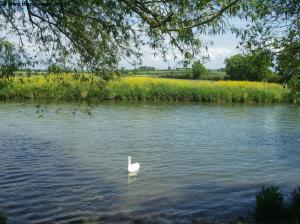 |
| The Thames north of Radley |
Soon you come towards the beautiful scene at Sandford-on-Thames. Although you first pass some fairly modern housing across the river, you cross the bridge over the Thames onto the island by the lock. Then you remain on the right-hand side of this island as you pass the lock, passing the pub on the right. Looking back to the lock and the pub is a beautiful sight, with the willow tree and buildings reflecting in the water.
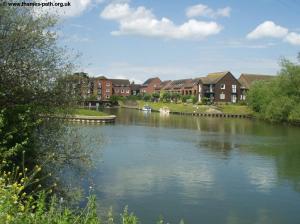 |
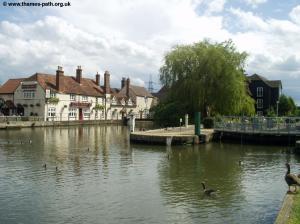 |
| Modern Housing at Sandford | Sandford Lock |
Beyond the lock the path still continues on the island for a while, passing over a footbridge near the large weir, before returning to south bank (or west as it is here) once more. Before you get to these bridges you might see an old boat gently rotting into the water. The river is also becoming increasingly busy, with pleasure boats from Oxford now making their way along the river.
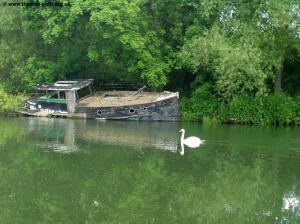 |
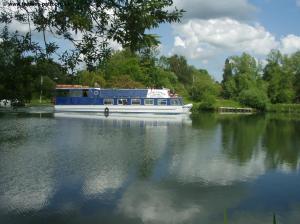 |
| An old boat beside the Thames | A pleasure boat making it's way down the Thames from Oxford |
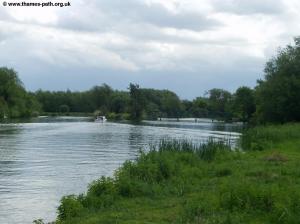 |
|
| The bridges at the end of the island |
The Thames now curves quickly to the left by a small island and returns to meadows, with the old railway bridge crossing the Thames ahead. Here we are now close to the housing of Kennington to the left, but the railway line appears to have prevented development next to the Thames.
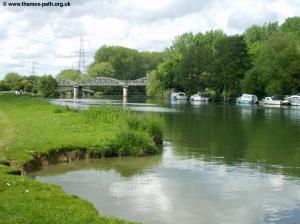 |
| The Railway bridge ahead |
Beyond the railway bridge you cross a footbridge over the Mill Stream and Hinksey Stream, flowing off to the left. You're now walking next to woods briefly before going under the busy A423 ahead.
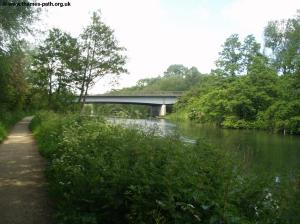 |
| The A423 road bridge |
Under the road bridge you'll see the lovely scene of Iffley Lock ahead, with the old wooden bridge over the weirs and the beautiful old buildings. This area is extremely historic, as the church across the other side of the river (St. Mary's) dates from 1170. The village itself is believed to date from around 1000 to 1050. A mill also stood on the banks of the river here for almost 800 years, but was sadly destroyed by fire in 1908.
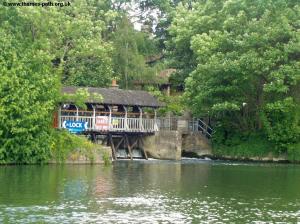 |
| Iffley Lock ahead |
At the lock itself the path crosses to the lock island via a small footbridge then crosses back to the Thames over and ancient looking stone footbridge. It's worth crossing the lock and weir however to have a look at the lovely village, with it's ancient church and thatched cottages. The lock itself is very well kept with a lovely stone lock keepers cottage and a popular pub.
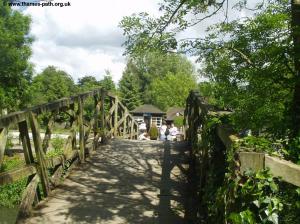 |
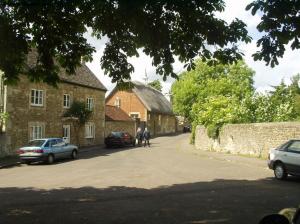 |
| Iffley Lock | Iffley Village |
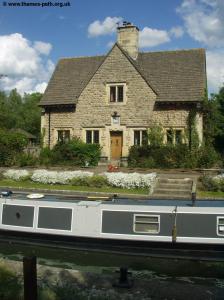 |
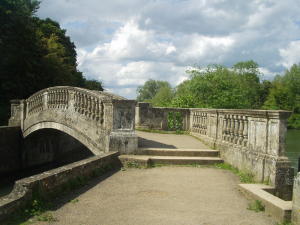 |
| Iffley Lock | The Stone bridge at Iffley Lock |
After the lock you walk through meadows and soon come to the first boat house on the right, before passing under the B4495 road bridge, which seems to have been decorated by some students (amusingly the other side of the bridge had "Boring Students" written across it). Beyond the bridge the opposite bank of the Thames is lined with the famous boat houses of Oxford University.
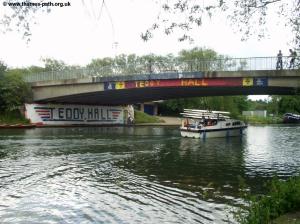 |
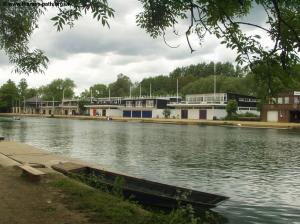 |
| The B4495 bridge | The University boat houses |
Beyond the boat houses are the Christ Church Meadows with the spires of the city just visible beyond. Soon you come to a small bridge, this time you have to climb up to the road to cross the bridge, but turning right when you get to this bridge will take you into the centre of Oxford with it's many beautiful buildings.
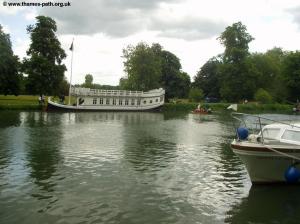 |
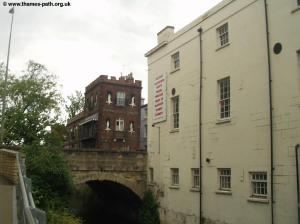 |
| The Thames near Christ Church meadows | The bridge near Oxford City Centre |
Surprisingly the river Thames through the centre of Oxford does not offer the best views of the city and seems to be a little neglected as a tourist attraction. Beyond the small road bridge it's something of a surprise to be walking through mainly a residential area. Soon the path again becomes more rural, surprising considering how close to the centre of a city the river is, passing under an elegant bridge followed, by the railway bridge. Beyond the railway bridge there is some industrial buildings to the left, but they are not particularly visible with the trees and bushes hiding them. Soon you come to Osney Lock, typical in style to many Thames locks, but seeming a bit more crammed in than most.
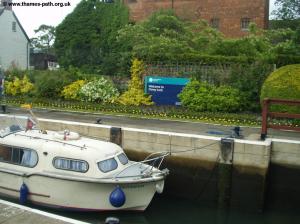 |
| Osney Lock |
Beyond the lock you emerge into a quiet tree-lined street with some attractive cottages, but somewhat dwarfed by the industrial buildings on the opposite bank of the river, which probably block much of the light.
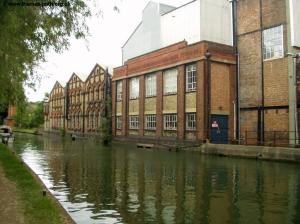 |
| Industrial buildings by the river |
Soon you come to the elegant Osney Bridge the last major bridge over the Thames in Oxford, and close to the station, making it an ideal place to finish.
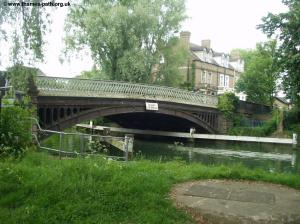 |
| Osney Bridge |
Getting Back
Once you come to the bridge go up onto the road and turn right where you go under a small subway and climb onto the blue bridge which will take you to the railway station. Oxford has excellent public transport. From the station Oxford Bus service X3 runs very frequently back to Abingdon. Oxford has frequent trains, operated by First Great Western Link to Didcot Parkway, Reading, Slough and London, taking around an hour to London. First Great Western Link also operate local services to Didcot and Reading calling at the smaller stations on the line, a branch line to Bicester and the Cotswold Line which goes from Oxford to Evesham, Worcester, Great Malvern and Hereford, as well as services to Banbury, Leamington, Warwick and Stratford-upon-Avon. Virgin Trains operate frequent services to Reading, Basingstoke, Southampton and Bournemouth to the south and to the north to Banbury, Leamington, Coventry, Birmingham, the North and Scotland.
Oxford also has excellent bus and coach services with two very frequent coach services to London. The Oxford Espress runs up to every 12 minutes at peak times and every 20 minutes during the day to London Victoria Coach station using modern air-conditioned coaches with toilets and even power points for laptops. This service also runs hourly throughout the night. The coach also stops at Marble Arch and Baker Street in London, taking around 90 minutes to get from Oxford to London. The Oxford Tube is another express coach service to London, running every 12 minutes throughout the day (every 15 minutes on Sunday) and every 30 to 60 minutes during the night. The double-decker coaches have air conditioning and toilets. These coaches run between Oxford and Shepherd's Bush, Notting Hill Gate, Marble Arch and Victoria in London and take around 100 minutes. Stagecoach Oxford also operate a coach service from Oxford to Bicester, Buckingham, Milton Keynes, Bedford and Cambridge. Oxford Bus also operate frequent coaches from Oxford to Heathrow and Gatwick Airports. A network of local buses, operated by Stagecoach Oxford and Oxford Bus go to most towns and villages nearby, including Abingdon, Didcot, Witney, Bicester, Swindon, Carterton, Brackley, Northampton and Banbury - for details see the links below.
Links
The following web sites provide information on the area.
Every effort is made to ensure the accuracy of information on this site, but liability will not be assumed in the event of any inaccuracies. Use of the information on this site is at your own risk. If you find any errors, please use the link below. The text and photographs on this web site are all Copyright © and may not be reproduced without prior permission